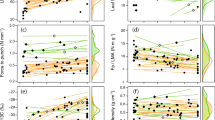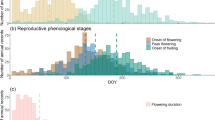Abstract
The factors determining herbaceous canopy architecture are poorlyunderstood, especially in natural and semi-natural plant communities. Inthis study, we tested three main hypotheses: (1) the structure of herbaceouscanopies can be explained by the vertical distribution of functional groupsdefined by leaf width and the presence/absence of leaves on upright stem;(2) the degree of canopy stratification is greater in habitats that experiencelower spatial heterogeneity in the supply of light (i.e., grasslands as opposedto forest herb layers); and (3) there is significant variation among specieswithin a growth-form, with respect to their vertical position in thecanopy. We used plant foliage height distribution data from 14 grassland and 13forest herbaceous communities to test these hypotheses. A general linear mixedmodel was applied to specify the proportions of total variance in the foliageheight, accounted for by the fixed effects of plants' basicgrowth-form properties (growth-form) and community type(forest/grassland), and by the random effects of sampling site, samplingpoint, and individual species. We were also interested in the correlation ofthedegree of the stratification with various community characteristics(productivity, other canopy properties, species richness, variation ofspecies' traits) and light availability. There was some evidence ofoverall canopy stratification according toplant growth-form, since plants with leafy stem were locatedsignificantly higher. However, such a pattern of two more or less distinctlayers (grasses + upright forbs and rosette forbs) occurred withconsistency only in grasslands (greater homogeneity in light). Thebetween-species variation within a growth-form was a highlysignificant predictor of canopy vertical structure in the 27 communities. Theproportion of total observed variance, explainable throughspecies-specific effects, was comparable to that caused bybetween-site differences. The effect of community horizontal pattern wasless obvious, but still significant. The site by site analysis revealed thatthe degree to which horizontalpatchiness explained variation in vertical canopy structure was negativelyrelated to the relative importance of species-specific effects, showingthat small between-species differences lead to a more obviouswithin-community horizontal pattern, and vice versa. The upper bound ofthe degree of foliage stratification, according to growth-form, wasrelated to the variability of species light requirements and to relative (tocommunity pool size) richness, indicating that certain aspects of canopyarchitecture might be explained through community species composition anddiversity pattern.
Similar content being viewed by others
References
Aerts R., Boot R.G.A. and van der Aart P.J.M. 1991. The relation between above-and below ground biomass allocation patterns and competitive ability. Oecologia 87: 551–559.
Aiba S.I. and Kohyama T. 1996. Tree species stratification in relation to allometry and demography in warm-temperate rain forest. Journal of Ecology 84: 207–218.
Anten N.P.R. and Hirose T. 1999. Insterspecific differences in aboveground growth patterns result in spatial and temporal partitioning of light among species in a tall-grass meadow. Journal of Ecology 87: 583–597.
Barkman J.J. 1988. New systems of plant growth forms and phenological plant types. In: Werger M.J.A., van der Aart P.J.M., During H.J. and Verhoeven J.T.A. (eds), Plant form and vegetation structure. SPB Academic Publishing, the Hague, pp. 9–44.
Bazzaz F.A. 1990. Plant-plant interactions in successional environments. In: Grace J. and Tilman D. (eds), Perspectives on plant competition. Academic Press, New York, pp. 239–263.
Berendse F. 1985. The effect of grazing on the outcome of competition between plant species with different nutrient requirements. Oikos 44: 35–39.
Blackburn T.M., Lawton J.H. and Perry J.N. 1992. A method of estimating the slope of upper bounds of plots of body size and abundance in natural animal assemblages. Oikos 65: 107–112.
Carson W.P. and Pickett S.T.A. 1990. Role of resources and disturbance in the organization of an old-field plant community. Ecology 71: 226–238.
Cernusca A. 1976. Energy exchange within individual layers of a meadow. Oecologia 23: 141–149.
Chapin F.S.I.I.I., Bret-Harte M.S., Hobbie S.E. and Zhong H. 1996. Plant functional types as predictors of transient responses of arctic vegetation of global change. Journal of Vegetation Science 7: 347–358.
Collins B. and Wein G. 1998. Soil heterogeneity effects on canopy structure and composition during early succession. Plant Ecology 138: 217–230.
Connolly J. and Wayne P. 1996. Asymmetric competition between plant species. Oecologia 108: 311–320.
Cowling R.M., Mustart P.J., Laurie H. and Richards M.B. 1994. Species diversity; functional diversity and functional redundancy in fynbos communities. South African Journal of Science 90: 333–337.
Dietz H., Steinlein T. and Ullmann I. 1998. The role of growth form and correlated traits in competitive ranking of six perennial ruderal plant species grown in unbalanced mixtures. Acta Oecologica 19: 25–36.
Eesti NSV floora 1959-1984. Flora of the Estonian S.S.R. I-XI. Eesti Riiklik Kirjastus, Tallinn.
Ellenberg H., Weber H.E., Düll R., Wirth V., Werner W. and Paulißen D. 1991. Zeigerwerte von Pflanzen in Mitteleuropa. Scripta Geobotanica 18: 1–248.
Gaudet C.L. and Keddy P.A. 1988. A comparative approach to predicting competitive ability from plants traits. Nature 334: 242–243.
Gimingham C.H. 1951. The use of life form and growth form in the analysis of community structure, as illustrated by a comparison of two dune communities. Journal of Ecology 39: 396–406.
Givnish T.J. 1982. On the adaptive significance of leaf height in forest herbs. American Naturalist 182: 353–381.
Givnish T.J. 1987. Comparative studies of leaf form: assessing the relative roles of selective pressures and phylogenetic constraints. New Phytologist 106: 131–160.
Goldberg D.E. and Weiner P.A. 1983. Equivalence of competitors in plant communities: a null hypothesis and a field experimental approach. American Journal of Botany 70: 1098–1104.
Grime J.P., Thompson K., Hunt R., Hodgson J.G., Cornelissen J.H.C., Rorison I.H. et al. 1997. Integrated screening validates primary axes of specialisation in plants. Oikos 79: 259–281.
Halloy S. 1990. A morphological classification of plants, with special reference to the New Zealand alpine flora. Journal of Vegetation Science 1: 291–304.
Hirose T. and Werger M.J.A. 1995. Canopy structure and photon flux partitioning among species in a herbaceous plant community. Ecology 76: 466–474.
Hutchings M.J. and de Kroon H. 1994. Foraging in plants: the role of morphological plasticity in resource acquisition. Advances in Ecological Research 25: 160–238.
Inouye R.S., Huntley N.J., Tilman D., Tester J.R., Stillwell M. and Zonnel K.C. 1987. Old-field succession on a Minnesota sand-plain. Ecology 68: 12–26.
Johnson I.R. and Thornley J.H.M. 1987. A model of shoot:root partitioning with optimal growth. Annals of Botany 60: 133–142.
Keddy P.A. and Shipley B. 1989. Competitive hierarchies in herbaceous plant communities. Oikos 54: 234–241.
Kikuzawa K. and Umeki K. 1996. Effect of canopy structure on degree of asymmetry of competition in two forest stands in nothern Japan. Annals of Botany 77: 565–571.
Kohyama T. 1992. Size-structured multi-species model of rain forest tress. Functional Ecology 6: 206–212.
Körner C. 1995. Scaling from species to vegetation: the usefulness of functional groups. In: Schulze E.D. and Mooney H.A. (eds), Bioadversity and Ecosystem Function. Springer-verlag, Berlin, pp. 117–140.
Lavorel S., McIntyre S., Landsberg J. and Forbes T.D.A. 1997. Plant functional classifications: from general groups to specific groups based on response to disturbance. Trends in Ecology and Evolution 12: 474–478.
Liira J. and Zobel K. 2000. Vertical structure of a species-rich grassland canopy, treated with additional illumination, fertilization and mowing. Plant Ecology 146: 183–193.
Littell R.C., Milliken G.A., Stroup W.W. and Wolfinger R.D. SAS Institute Inc. 1996. SAS® system for mixed models. SAS Institute Inc., Cary, NC.
Mitchley J. 1988. Control of relative abundance of perennials in chalk grassland in Southern England. II. Vertical canopy structure. Jounal of Ecology 76: 341–350.
Mitchley J. and Willems J.H. 1995. Vertical canopy structure of Dutch chalk grasslands in relation to their management. Vegetatio 117: 17–27.
Neter J., Kutner M.H., Nachtsheim C.J. and Wasserman W. 1996. Applied linear statistical models. 4th edn. Irwin, Chicago.
Parker G.G. and Brown M.J. 2000. Forest canopy stratification - is it useful? American Naturalist 155: 473–484.
Parkhurst D.F. and Loucks Q.L. 1972. Optimal leaf size in relation to environment. Journal of Ecology 60: 505–537.
Pärtel M., Zobel M., Zobel K. and van der Maarel E. 1996. The species pool and its relation to species richness: evidence from Estonian plant communities. Oikos 75: 111–117.
Pickett S.T.A., Kolasa J., Armesto J.J. and Collins S.L. 1989. The ecological concept of disturbance and its expression at various hierarchical levels. Oikos 54: 129–136.
Pokarzhevskaya G.A. 1995. Morphological analysis of Apline communities of the north-western Caucasus. Folia Geobotanica and Phytotaxonomica 30: 179–210.
SAS Institute 1989. SAS/STAT® user's guide. Version 6. 4th edn. Vol. 2. SAS Institute Inc., Cary, NC.
SAS Institute 1992. SAS. The techinical report P-220, SAS/ STAT®. Software: changes and enhancements release 6.07. SAS Institute, Cary, NC.
Scharf F.S., Juanes F. and Sutherland M. 1998. Inferring ecological relationships from the edges of scatter diagrams: comparison of regression techniques. Ecology 79: 448–460.
1995. Bioadversity and Ecosystem Function. In: Schulze E.D. and Mooney H.A. (eds). Springer-Verlag, Berlin, Germany.
Skarpe C. 1996. Plant functional types and climate in a southern African savanna. Journal of Vegetation Science 7: 397–404.
Tappeiner U. and Cernuska A. 1996. Microclimate and fluxes of water vapour, sensible heat and carbon dioxide in structurally differing subalpine plant communities in the Central Caucasus. Plant, Cell and Environment 19: 403–417.
Valladares F. 1999. Architecture, ecology, and evolution of plant crowns. In: Pugnaire F.I. and Valladares F. (eds), Handbook of functional plant ecology. Marcel Dekker, New York, pp. 121–194.
Werger M.J.A. 1983. Grassland structure in a gradient situation. Verhandlungen der Gesellschaft für Ökologie 11: 455–461.
Willems J.H., Peet R.K. and Bik L. 1993. Changes in chalk-grass-land structure and species richness from selective nutrient additions. Journal of Vegetation Science 4: 203–212.
Yokozawa M. and Hara T. 1995. Foliage profile, size structure and stem diameter-plant height relationship in crowded plant populations. Annals of Botany 76: 271–285.
Zobel K. and Liira J. 1997. A scale-independent approach to the richness vs. biomass relationship in ground-layer plant communities. Oikos 80: 325–332.
Zobel K., Moora M., Brown V.K., Niemelä P. and Zobel M. 1997. Secondary succession and herbivory in a subarctic grassland: community structure and diversity. Ecography 20: 595–604.
Zobel M., Suurkast M., Rosén E. and Pärtel M. 1996. The dynamics of species richness in an experimentally restored calcareous grassland. Journal of Vegetation Science 7: 203–210.
Author information
Authors and Affiliations
Rights and permissions
About this article
Cite this article
Liira, J., Zobel, K., Mägi, R. et al. Vertical structure of herbaceous canopies: the importance of plant growth-form and species-specific traits. Plant Ecology 163, 123–134 (2002). https://doi.org/10.1023/A:1020365402855
Issue Date:
DOI: https://doi.org/10.1023/A:1020365402855




